System Settings
The Pane System
Drives
Hard Disk Sleep Timer
Nearly all hard drives contain a built-in sleep timer which is designed to power down the spindle motor, saving energy when the drive has not been in use for some specified time. macOS supports a simple yes/no setting to manage this sleep feature of hard drives. It can be controlled by the option Put hard disks to sleep when possible on the pane Energy Saver (or Battery, respectively) of the System Settings application. Enabling this option corresponds to setting the sleep timer of disk drives to a value of 10 minutes of inactivity.

With TinkerTool System, you can control the sleep timers of hard disks more precisely, by specifying the exact value for the timer. Time intervals between 1 minute and 2 hours 59 minutes can be selected. To change the sleep timer of all disk drives, perform the following steps:
- Open the sub-item Drives on the pane System.
- Drag the slider Put hard disks to sleep when not in use after… to the desired value.
Throttling of Low-Priority Operations
The kernel of the operating system uses priorities to organize its Input/Output Jobs, mainly disk and network operations that must be executed as service for the applications currently running. Work carried out for invisible background applications (like Time Machine, for example) has lower priority than operations performed for interactive applications (like a text-processing program). Operations with low priority are throttled which means they are artificially slowed down, by letting them pause for certain small time intervals.
In some situations, this performance penalty can become tedious, e.g. when you are waiting for an extensive Time Machine backup run to complete. Time Machine jobs are mainly made up of input/output operations on disks or network, so they are significantly affected by this slow-down.
You can temporarily disable throttling of input/output operations for background applications, giving them the same priority as other tasks. The change becomes effective immediately, but is not permanently stored as a preference. The setting will only be retained until you either shut down the operating system or change the setting again.
To disable low-priority throttling for I/O operations in the kernel perform the following steps:
- Open the sub-item Drives on the pane System.
- Set a check mark at Disable artificial slowdown for background jobs.
Under very rare circumstances, running jobs could block each other while throttling is disabled, causing the system to freeze. Because all I/O operations run with the same priority in this case, the system can no longer reschedule important jobs to run before low-priority ones. High-priority operations may need to wait for a large number of low-priority ones, increasing the likelihood that jobs that depend on each other start waiting in circular fashion, causing a mutual blockage.
Volumes
macOS follows the strategy to automatically detect all disk drives and all their volumes currently connected to the computer, making them active and visible on the user interface. This might not be useful in certain situations, for example when you have a Windows partition on your computer which you don’t need when working with macOS, or when you keep a backup copy of your system volume in reserve on a secondary disk drive. With the help of TinkerTool System, you can tell macOS not to activate specific volumes automatically.
This setting only takes effect for purely automatic mount operations. If you are using an encrypted disk, macOS will always try to determine whether this disk contains volumes, and this disk has no readable identification (because it is encrypted). When you enter the password for unlocking, the corresponding volumes will be mounted, because this is a manual activation of this disk.
A second, independent option allows you to choose whether the system should allow the execution of programs which are stored on specific volumes. This feature can be useful if you connect “foreign” drives to your system that contain applications written for other operating systems, incompatible with macOS. You can no longer mistakenly try to open programs on such drives.
In both cases, macOS must have a way of reliably referring to each drive and volume. This is done by so-called Universal Unique Identifiers (UUIDs), a sequence of characters like 7F176A72–72B2–3D69–19FC–27ABBEFA662D which are guaranteed to be unique for every volume of every disk drive in the world. You don’t need to enter these UUIDs by hand. TinkerTool System automatically finds out the UUIDs and helps you to identify the drives by specifying their current volume names and file systems.
In addition to the mentioned limitations for encrypted volumes, further limitations exist for volumes which are mounted by user applications, so they are not handled by macOS itself. Such volumes are either directly excluded by TinkerTool System because they are detected as not being compatible with the volume tables, or inserting such volumes into the tables won’t have any technical effect, because macOS does not participate in the mount operation. An example for such a user program is Apple’s technology LIFS (Live File Provider File System) or the third-party software macFUSE (Macintosh File System in User Space). In some versions of macOS LIFS is used by default to process foreign file systems such as ExFAT or NTFS. Apple’s usage of LIFS may vary in each version of macOS.
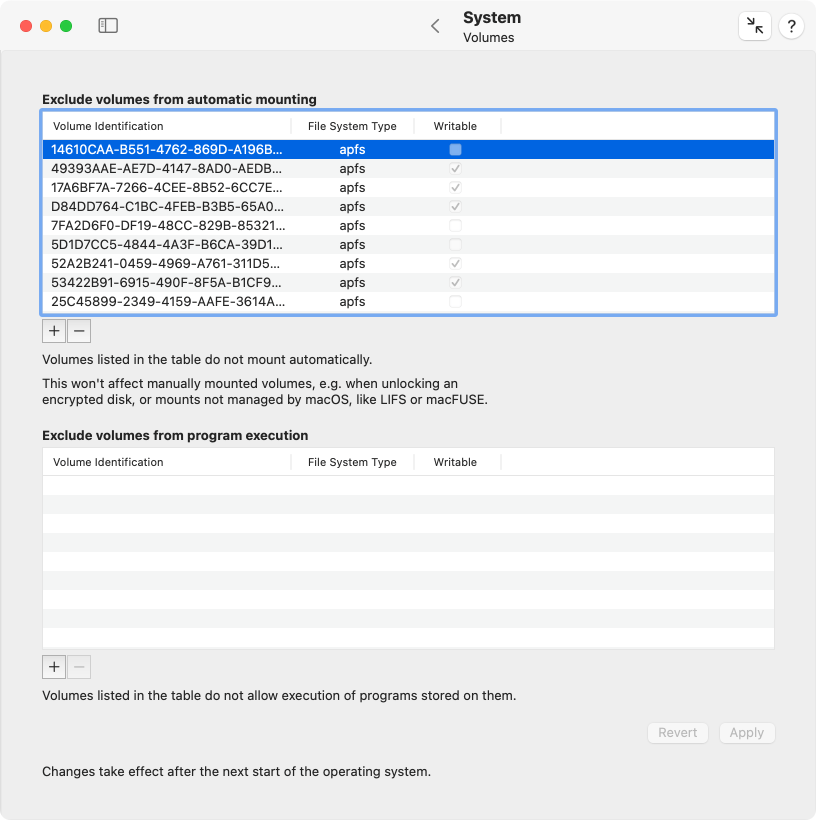
Perform the following steps when you like to exclude certain disk volumes from automatic mounting or execution of programs:
- Open the sub-item Volumes on the pane System.
- Click the [+] button below the table which refers to the option you like to activate.
- In the dialog sheet, select one or more disk volumes and click OK.
- After all volumes have been set as intended, click the button Apply in the lower right corner of the window.
It is also possible to drag volumes from the Desktop or the Finder’s computer folder directly into the tables. You can remove one or more volumes by clicking the [—] button below the respective table, and saving your modifications. To discard your changes and return the tables to the state currently established in macOS, click the Revert button.
After adding new volumes to the Exclude volumes from automatic mounting table, TinkerTool System will ask you whether you like to eject the affected volumes immediately when applying the changes.
If you have additional copies of macOS installed on your Mac, and you added one or more system volumes containing macOS 11 or later to an exclusion table of the system you are currently running, you may notice that the table entries for these volumes no longer take effect after you have performed an update or upgrade on the related system volumes. This is the correct and expected behavior because a modern macOS update deletes the previous system volume and adds a new one with the same name.
TinkerTool System can assist here: When the application detects this specific situation, the additional button Update system volumes… will automatically appear below the tables. Click this button to review the affected entries. After clicking Update tables, the identifications of the affected system volumes will be updated automatically to reflect the new configuration. The update button won’t be available when you begin to edit the tables manually.
Spotlight
Spotlight Operation
Spotlight is the built-in search technology of macOS which is designed to find files very rapidly after the user has specified key words or other search criteria. The technical implementation is based on several system services which operate silently in the background. However, Spotlight can sometimes be affected by technical problems, so administrators may need to fine-tune Spotlight operations in certain situations.
Spotlight is designed to operate as one of the basic core components of macOS. For this reason, other system services and many applications developed for macOS depend on the correct operation of Spotlight and will fail when Spotlight has been shut down. This includes the Time Machine backup service and the App Store application. For this reason, TinkerTool System does not support any operation to disable Spotlight completely. However, you can shut down Spotlight indexing on selected disk volumes.
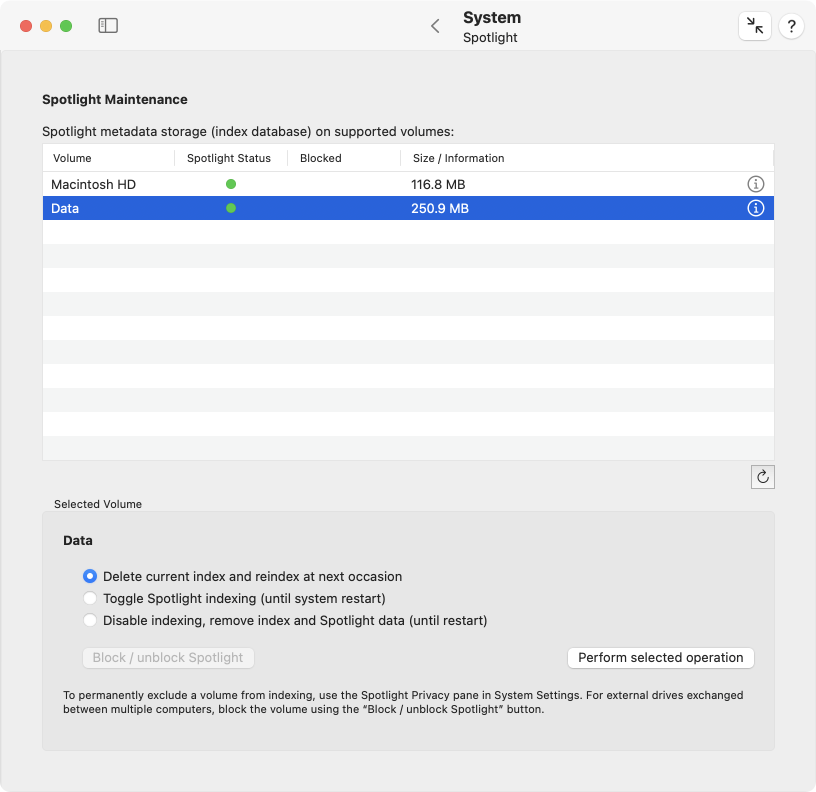
Spotlight Index Databases
When Spotlight is active, it automatically creates a hidden index database and some preference files on each volume currently connected with your computer. The database and the preference settings are needed to quickly find the contents you are searching for. These hidden components are called Metadata Stores.
For each of the volumes, TinkerTool System allows you to display whether Spotlight is activated on that volume (column Spotlight Status with indicator in green or red), whether Spotlight is generally disabled (column Blocked) and how much storage space is currently needed by the Metadata Stores. This information is displayed in the table Spotlight Metadata Storage. Only volumes which are technically capable of supporting Spotlight are listed in the table. A refresh button right below the table will update the contents of the table. This step is necessary to let macOS allow TinkerTool System (after authentication) to compute the size of the index databases. Access to the databases is protected because they contain potentially confidential information, namely all words of all documents all users have stored on the current computer.
After selecting a line in the table, you can activate several operations that should be performed:
- You can delete the metadata store on the selected volume. This will reset the privacy settings for this volume and enforces complete reindexing of all documents stored on the volume. This feature is helpful when the metadata appears to have been damaged. You would typically use this function when you detect that Spotlight finds less documents than it actually should.
- You can toggle Spotlight indexing, which means all indexing operations on the selected volumes will either be stopped, or be re-enabled for the currently running session of macOS. If you re-enable indexing, macOS will resume the background index operations at its own discretion at a later time.
- You can remove the metadata stores on the selected volume and disable indexing at the same time. The search database will be removed and Spotlight will no longer touch the affected volumes in the currently running macOS session.
To activate one of these functions, click the button Perform selected operation.
Note that the deactivation of index operations is only in effect until you restart macOS. Unless Spotlight isn’t blocked on affected volumes by using the setting Siri & Spotlight > Spotlight Privacy… in System Settings, macOS will recommence its indexing services upon next startup.
When you click the info symbol at the end of a table line, you can get further details about Spotlight for the corresponding volume. The application will open an additional panel with the following data:
- the current position in the UNIX file system where the volume is actually located
- a detailed presentation of status, memory usage, and possible blocking
- the information whether blocking is generally possible at the technical level and also not discouraged by TinkerTool System
- the operating system version used to configure Spotlight originally on this volume, together with the time specification
- the operating system version used the last time to modify the configuration of Spotlight, together with the time specification
- a list of UNIX file paths locked out expressly by one or more users for search operations
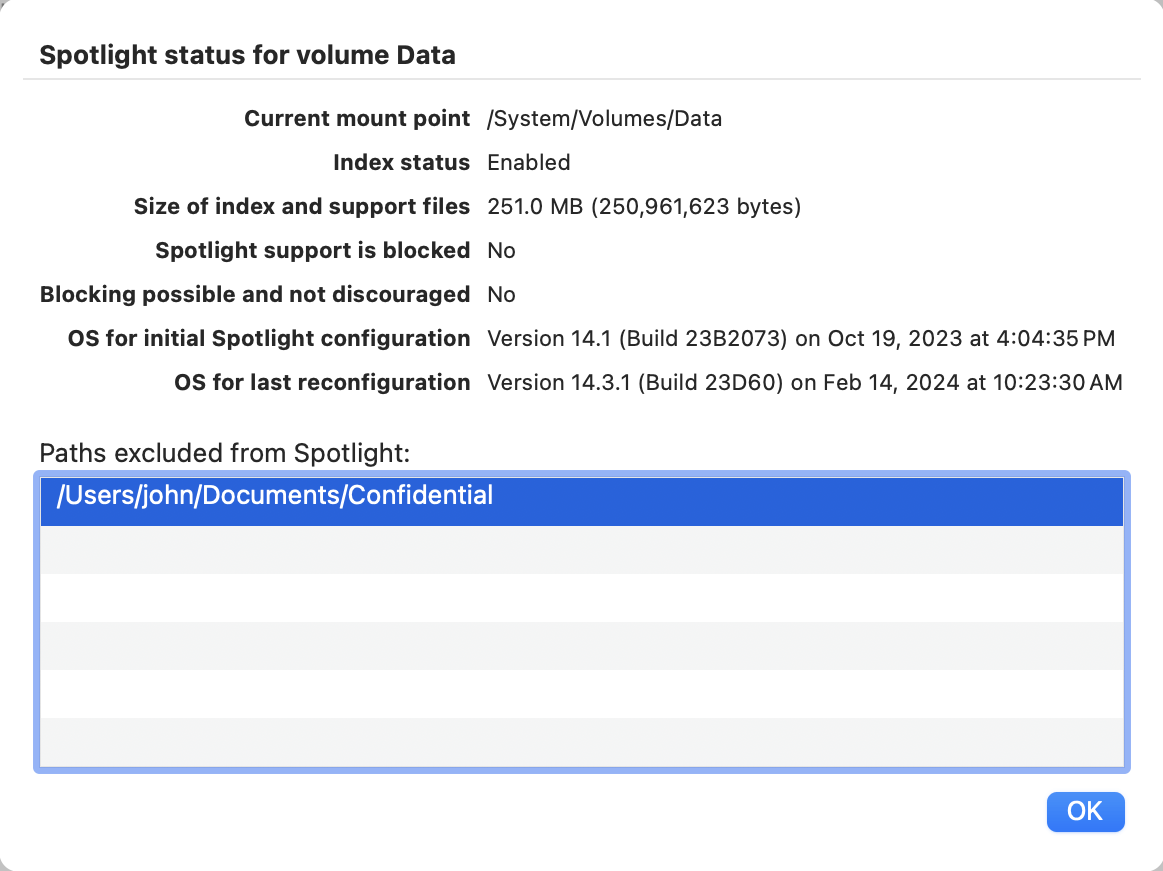
Under specific circumstances, it might be helpful to disable Spotlight operations on a disk volume “forever,” e.g. on a slow pen drive which you only use to transport data to other computers. This can be done by a special marker which works independently of the Spotlight privacy settings. Setting such a marker is particularly helpful on external drives which are used with different macOS computers, because all systems will automatically respect this setting after it has been established. To set or remove this marker, perform the following steps:
- Open the sub-item Spotlight on the pane System.
- Click the refresh arrow at the right hand side below the table to ensure the program had the chance to analyze all volumes completely.
- Select the desired volume in the table.
- Click the button Block/unblock Spotlight in the lower left corner.
Actions that could cause severe damage to the normal operation of macOS, e.g. removing the Spotlight index of Time Machine, are disabled automatically.
You should avoid to send Spotlight commands that contradict each other within short time frames, e.g. switching the index off, on, then off again. Spotlight works asynchronously in the background and may need several minutes to complete a command successfully. If an incomplete operation is still running in the background, the status display can be temporarily inconsistent, or a volume might even disappear completely from the table.
If you have triggered a command to have a search index be recreated, you can check as follows whether the indexing operating has actually been completed in the background:
- Open a Spotlight search inquiry via the Spotlight icon (magnifying glass) at the right hand side of the menu bar and enter a file name that you know exists on the affected volume.
- Leave the dialog open for a few seconds.
If the Spotlight index is not ready yet, macOS will show a progress bar after a few seconds, to indicate how much time it needs until the index will be complete. When the Spotlight index is ready, the search results will be shown without an additional progress indicator.
Network
Options for Connecting to File Servers
When you attempt to connect to a file server manually, a password entry panel will appear. TinkerTool System can modify the system setting that controls which name macOS should suggest in this panel. You can select between the short name of the current user, another preconfigured name, or the option not to suggest any name (No name). Perform the following steps:
- Open the sub-item Network on the pane System.
- Choose the desired option at Suggested name in panel.
Outdated authentication methods
Apple has deprecated the use of certain outdated authentication methods, which are considered unsafe according to today’s standards when connecting to AFP servers. The operating system won’t offer the affected authentication methods when contacting a server. This can however mean that you can no longer connect to old servers successfully. TinkerTool System allows you to unlock certain methods so that they can be used again. Perform the following steps:
- Open the sub-item Network on the pane System.
- Set check marks for all desired options at Allow outdated authentication methods.
The following methods can be reactivated:
- Two-way random number exchange
- Diffie-Hellman Key Exchange, implemented with the CBC128 procedure (Carlisle Adams / Stafford Tavares encryption with 128 bits in Cipher Block Chaining mode)
- Password transfer in the clear
- Encryption method version 2 of “Microsoft® Services für Macintosh”
Because all these methods are insecure and outdated and use of AFP technology is deprecated, you should only enable as few options as possible in order not to compromise the security of your network.
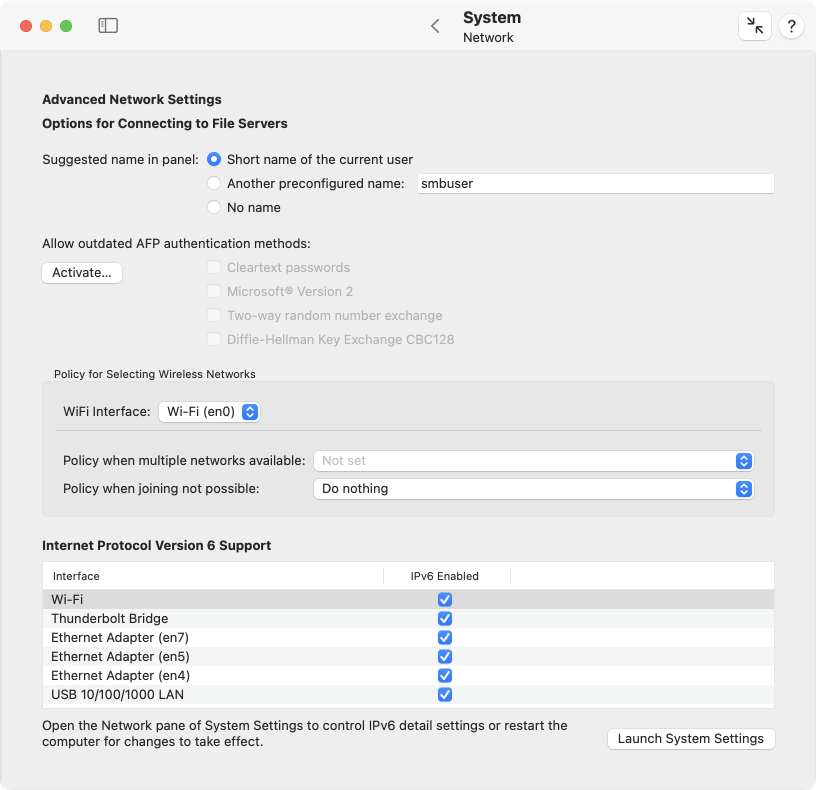
Policy for Selecting Wireless Networks
Each WiFi unit attached to your Mac is supporting two settings which are normally invisible at the graphical user interface: These preference settings control which strategy macOS should use when joining one of the available wireless networks. The setting Policy when multiple networks available controls which network should be chosen if more than one is accessible in the current environment. Accessible means that signal reception is good enough and the credentials for a possible encryption of the network are known. The following settings are possible:
- Automatic: macOS should choose the “best” network at its own discretion.
- Select preferred network: The network which this Mac joined most frequently in the past should be chosen.
- Select by ranking: By using the current configuration in System Settings and the observed connections in the past, the system should create a ranking and choose the first network in this list.
- Select recent network: The network to which the Mac was last connected should be used.
- Select strongest network: The network that is best receivable at the moment should be selected.
The special menu item Not set indicates that macOS has not set a specific policy since the operating system has been installed. This entry cannot be selected.
If connecting to the network that was chosen by this policy is not possible or was not successful, the second setting Policy when joining not possible takes effect. Here, the following values can be set:
- Ask user: A dialog is shown that asks the user how to proceed.
- Join next open network: The first best network without encryption is chosen, even if it is not known from the past.
- Keep looking: The search should continue until a connection succeeds.
- Do nothing: After a failure to join the network, the search should be canceled. In this case, no wireless connection is made.
Internet Protocol Version 6 Support
By default, the pane Network of the application System Settings does not show a menu item to disable the support of IPv6 on specific network interfaces. The feature to switch IPv6 to Off is present in the operating system, however. You can use TinkerTool System to control this option.
- Open the sub-item Network on the pane System of TinkerTool System.
- Locate the network service you like to modify in the table Internet Protocol Version 6 Support.
- Remove the check mark in the column IPv6 Enabled to disable IPv6 for the network interface in that line.
When you have disabled IPv6 support for an active network service, System Settings will correctly reflect this, adding an Off menu item to the Configure IPv6 option. You can either use System Settings or TinkerTool System to re-enable this feature later. If you use TinkerTool System to do this, your configuration setting automatically switches back to the mode previously defined in System Settings.
If you change your network location or the IPv6 mode in System Settings while TinkerTool System is running, it is recommended to restart TinkerTool System to ensure that the application shows the updated status.
Permission Filter for New File System Objects
In the permission system of macOS, which is explained in detail in the chapter The Pane ACL Permissions, each application decides for itself what rights it will grant for a new a file or folder when that file system object is being created. This also includes the Finder which is the typical application to create new folders.
Security problems could arise if you are using badly written or very old applications which don’t care about permission settings. Such applications could grant write permission to the category “other users” which means that nearly everyone — no matter if the user is even “known” by the current computer — could access, overwrite, and delete each and every document created by that program. In environments where users cannot be considered to behave cooperatively, like schools or large companies, such a lax policy of granting permissions can make a system unusable. For this reason, macOS and every other UNIX system is using a permission filter: Whenever an application creates a new file or folder and has to set the initial permission settings, the permissions will be sent through a filter first which decides if applications are allowed to grant a specific right or not. The filter corresponds directly with the three POSIX rights read, write, execute, and the access parties owner, group owner, and others. See the chapter The Pane ACL Permissions for details.
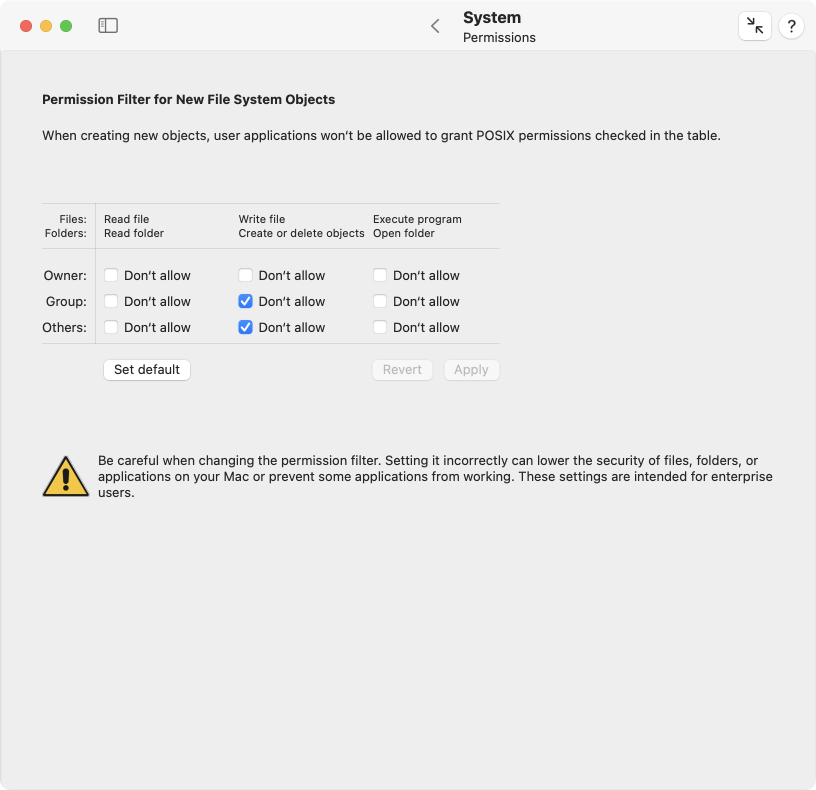
By default, macOS uses a permission filter which is preconfigured with the following policy:
- don’t allow applications to grant initial write permission for the group owner of a new object
- don’t allow applications to grant initial write permission for other users, who are neither owner nor group owner of the new object.
Administrators can change this policy, modifying the permission filter so that the initial permissions are either relaxed or become even stricter. To modify the permission filter of macOS, perform the following steps:
- Open the sub-item Permissions on the pane System.
- Set or remove check marks in the table Permission Filter for New File Systems Objects. The lines of the table represent the three access parties Owner, Group, and Others, the columns represent the rights which should be blocked when creating new objects, namely read, write and execute. Remember that write permission for a folder means the right to create, rename and delete objects in the folder, and that execute permission for a folder means to browse the contents of a folder.
- Click the button Apply below the table.
The change will take effect the next time you start the computer. The button Set Default can be clicked to return to the recommended standard filter. Clicking the button Revert will cause TinkerTool System to discard your changes and to display the settings currently established in the system.
Warning: It is very dangerous to set check marks in the line Owner. Enabling a filter option in this section means that applications will no longer have the right to access the files they just have created.
The setting only affects programs started in user sessions. Background programs of the operating system won’t be affected (unless they are started as part of a user session).
There are specific circumstances where TinkerTool System detects that it won’t be possible to modify the permission filter. In this case, the table is disabled and an error message appears below. The following situations can cause such a problem:
- A pending operation to change the filter is currently in progress. New values have been set to be established but the computer has not been restarted yet.
- Some third-party application is manipulating the permission filter. This could be intended by the other application but it could also indicate a defect. It won’t be possible to change the filter settings until this problem has been resolved.
Miscellaneous
Control the Security Policy for Remote Apple Events
As of version 10.15, macOS follows stricter security guidelines as earlier operating system versions regarding the use of AppleScript and the associated Apple Events over a remote network connection. An Apple Event that targets an application on a remote system must authenticate as the same user on the remote system. If it doesn’t do so, the sending application will receive a procNotFound error. If you like to relax this rule, using the less secure policy of older operating systems, perform the following steps on the computer that receives remote Apple Events:
- Open the sub-item Miscellaneous on the pane System.
- Remove the check mark at Require matching user account on clients to access the current login session.
The new setting does not take effect immediately. To enforce an update, either restart the computer, or toggle the Remote Apple Events setting in the General > Sharing pane of System Settings twice.
Screen Sharing
If a remote administrator uses the screen sharing feature of macOS to receive the current contents of the computer screen on her own computer across a network connection, macOS automatically tries to protect the privacy of the user currently working on the local screen: If the remote administrator connects with a user account which is different from the one of the local user, the screen session won’t begin immediately. Instead, the accessing user is asked whether he likes to work on his own, separate screen, or if the local user should be asked to grant permission that the remote user can see and take over the current screen. The local user could have private or confidential information on screen, so this behavior will protect the displayed data.
In some cases, this policy may not be useful. You can disable this privacy feature as follows:
- Open the sub-item Miscellaneous on the pane System.
- Click on the item Permit clients to take over frontmost screen session.
You should check if this policy is compliant with local laws and the guidelines of your organization, if applicable.
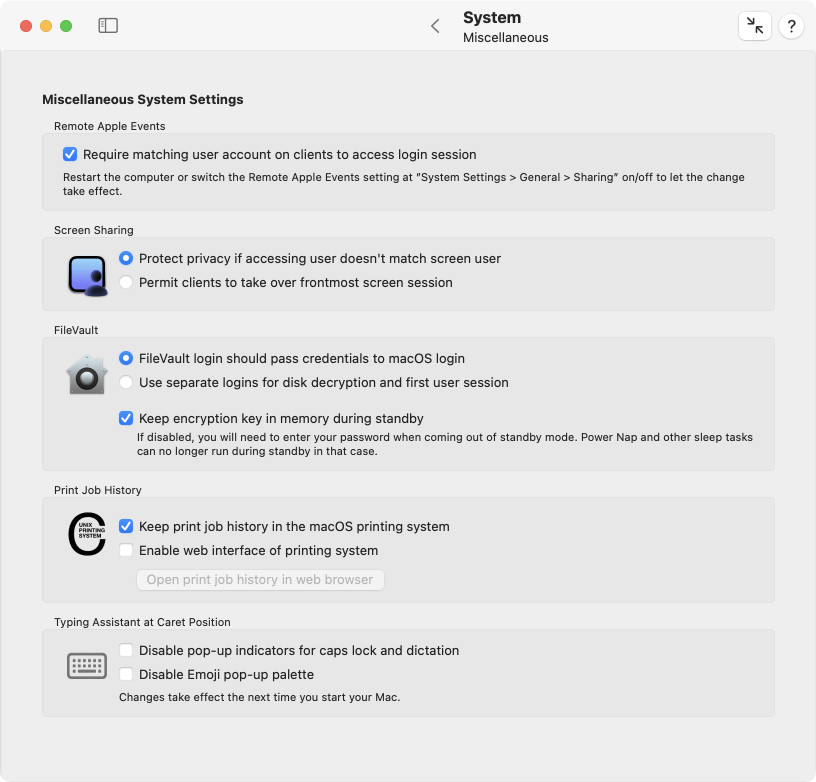
FileVault Options
If you enabled FileVault on your computer, the entire system volume will be encrypted by a secure key and a password will be necessary to unlock and decrypt the disk. When the computer is switched on, the operating system cannot start immediately, because the Mac cannot read the encrypted disk. Instead, the computer’s firmware and some parts of the unencrypted preboot volume present a special login screen (which resembles the login screen of macOS). Users have to log in here first, and for entitled users, the secret decryption key will be unlocked, which is then used to decrypt the operating system volume and to launch macOS.
At this stage, it is known that the user who unlocked the disk must also be a valid user of macOS, so the firmware passes the name and password of this user to the operating system, performing an automatic login, hereby avoiding to ask for credentials a second time. For this reason, the activation of FileVault automatically enables the automatic login feature of macOS, too.
In some cases, this behavior might not be intended. macOS supports a special feature to uncouple the decryption of the FileVault disk from the initial login upon start of the operating system:
- Open the sub-item Miscellaneous on the pane System.
- Click on the item Use separate logins for disk decryption and first user session.
You can also enable an advanced security feature of FileVault for cases where this is needed. To guarantee continued access to storage media, your Mac must always keep the key for disk encryption in memory in order to successfully process any block on the disk the operating system needs to read or write. That includes time periods where your Mac enters sleep and standby modes. This is necessary to ensure that the Mac can still perform regular maintenance tasks when not being fully switched on and to execute Power Nap functions.
This policy maintains a certain comfort level, but can become an issue should your Mac be stolen, when an attacker tries to get direct memory access by connecting special hardware devices to the sleeping Mac. In theory, the disk encryption key could be disclosed this way.
By removing the check mark Keep encryption key in memory during standby you can avoid this possible method of attack. If this option is not checked, macOS will destroy the FileVault key in RAM when the system enters standby mode. In this configuration, your Mac will no longer have disk access during standby, so Power Nap and similar maintenance features will no longer be active regardless how you have configured them.
Print Job History
The printing features of macOS are implemented by CUPS, the Common Unix Printing System. By default, macOS keeps a log of all print jobs ever processed by the local computer, the print job history. TinkerTool System can disable the log if desired, and it can show you the records currently in the log. To change the system setting for keeping print job records, perform the following steps:
- Open the sub-item Miscellaneous on the pane System.
- Set or remove the check mark Keep print job history in the macOS printing system.
The log can be reviewed by clicking the button Open print job history in web browser. TinkerTool System will delegate this task to your preferred web browser. Web access to the printing subsystem is inactive by default in several versions of macOS. By using the option Enable web interface of printing system you can control whether web access should be possible or not.
Typing Assistant at Caret Position (macOS Sonoma or later only)
With macOS 14, Apple has introduced new pop-ups when typing text, which are displayed right next to the cursor, at the insert position of the text. Many users find these pop-ups annoying. You can turn them off with TinkerTool System, which is done system-wide (for all users of the computer). Two system settings are available:
- the pop-up for the Caps Lock key (capital letters) and for text dictation
- the pop-up of a palette with suggestions for emojis when you have entered appropriate text and open the menu item Edit > Emoji & Symbols or press the corresponding keyboard shortcut.
Perform the following steps to change these system settings:
- Open the sub-item Miscellaneous on the pane System.
- Set or remove check marks at Typing Assistant at Caret Position.
- Restart your Mac if you like the change to take effect immediately.